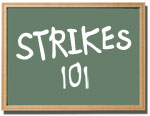|
 A strike is the most recognizable and publicized element of a workplace dispute, but it’s also one of the most confusing and misunderstood. This simple guide helps clarify what a strike is and what’s involved. A strike is the most recognizable and publicized element of a workplace dispute, but it’s also one of the most confusing and misunderstood. This simple guide helps clarify what a strike is and what’s involved.
(Download the printable PDF version too!)
What is a strike?
-
A strike occurs when workers withhold labor in order to improve their working conditions.
-
Strikes are often the most impactful way workers can use their collective power to influence terms and conditions of their employment.
Why do employees choose to strike?
-
Employees may choose to strike when: 1. an employer commits an unfair labor practice, such as refusing to recognize its workers as a union; or 2. the employer, employees, and their union are unable to reach a collective bargaining agreement and the most recent proposal on the table is unacceptable to employees.
-
Union members vote on whether or not to strike. Because of the personal and collective sacrifices striking requires of workers, many unions require a two-thirds majority vote in order to strike.
-
Workers don’t always strike over “bread and butter” issues like wages and benefits. Teachers have gone on strike to improve class size; warehouse workers have gone on strike over unsafe conditions; and machinists have gone on strike to keep jobs from going overseas.
-
Strikes can be undertaken as a last resort by employees wanting to resolve a significant labor dispute with their employer or when matters are at an impasse and workers have exhausted all other options.
What’s at stake for striking employees?
-
Strikes can pose significant risks for employees, which is why workers and their unions don’t take the decision to strike lightly.
-
Even if they receive a modest level of financial assistance through their union’s strike fund, workers are not paid by their employer during a strike.
-
There is no guarantee that an employer will meet the demands of striking workers.
-
Workers engaged in an economic strike can lose their jobs if their employer decides to hire permanent replacements.
Are strikes legal?
-
U.S. workers have held the legal right to strike for more than 75 years. Depending on the sector and industry in which someone works, various laws dictate when and how a strike can occur.
-
Workers generally do not have to be in a recognized union in order to strike.
-
The National Labor Relations Act (NLRA) grants the majority of private sector employees the right to strike. Farmworkers, domestic workers, independent contractors and some supervisors are explicitly exempted from the law. The Railway Labor Act protects the right of workers specifically in the railway and airline industries to strike in certain circumstances.
-
Federal government workers do not have the right to strike. State and local government workers only have the right to strike if their state allows it by statute. Workers in essential services – police officers, firefighters, and prison guards – generally never have the right to strike.
-
The International Labor Organization considers the right to strike essential to freedom of association, as long as it doesn’t interfere with public safety.
Types of strikes
-
An unfair labor practice (ULP) strike is in response to an employer violating federal labor law – for instance, when an employer fires employees for attempting to form a union. Workers cannot be permanently replaced in a ULP strike.
-
An economic strike is when workers strike to compel an employer to modify a bargaining position – such as when an employer insists on cutting pay and benefits. In these strikes, an employer can permanently replace workers.
-
A sympathy strike occurs when workers strike in solidarity with other striking or locked-out workers. For example, union-represented delivery drivers may refuse to cross a picket line to deliver packages to a company whose employees are on strike, even though they are not directly involved in the dispute. If workers honor a ULP strike, they cannot be permanently replaced, whereas if they honor an economic strike, they can be permanently replaced.
What’s the difference between a strike, a lockout, and a work stoppage?
-
A strike is the opposite of a lockout, which is an employer-initiated action that prevents employees from working.
-
Employees can stop working temporarily in response to abnormally dangerous working conditions. This is considered a work stoppage, not a strike, and workers must return to work when the conditions are properly addressed. When employees covered by the NLRA engage in a work stoppage, employers cannot permanently replace the workers because it’s not considered a strike.
How often do strikes occur?
-
The Bureau of Labor Statistics tracks strikes and lockouts involving more than 1,000 employees.i In 2011 there were 19 large strikes and lockouts, a rise from 11 in 2010 and 5 in 2009. However, from the 1940s up until the late 1970s, there were hundreds per year.
-
Scholars have attributed the employer’s ability to permanently replace striking employees as a reason for the sharp decline in strikes in the United States.ii Because U.S. employers can permanently replace workers engaged in an economic strike, the International Labor Organization considers the United States in violation of international standards on the freedom to associate.iii
Download a printable PDF of Strikes 101.
|


 A strike is the most recognizable and publicized element of a workplace dispute, but it’s also one of the most confusing and misunderstood. This simple guide helps clarify what a strike is and what’s involved.
A strike is the most recognizable and publicized element of a workplace dispute, but it’s also one of the most confusing and misunderstood. This simple guide helps clarify what a strike is and what’s involved.

